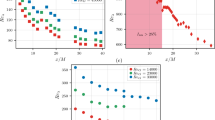Abstract
We present an empirical but simple and practical spectral chart method for determining the mean turbulent kinetic energy dissipation rate \( \left\langle \varepsilon \right\rangle \) in a variety of turbulent flows. The method relies on the validity of the first similarity hypothesis of Kolmogorov (C R (Doklady) Acad Sci R R SS, NS 30:301–305, 1941) (or K41) which implies that spectra of velocity fluctuations scale on the kinematic viscosity ν and \( \left\langle \varepsilon \right\rangle \) at large Reynolds numbers. However, the evidence, based on the DNS spectra, points to this scaling being also valid at small Reynolds numbers, provided effects due to inhomogeneities in the flow are negligible. The methods avoid the difficulty associated with estimating time or spatial derivatives of the velocity fluctuations. It also avoids using the second hypothesis of K41, which implies the existence of a −5/3 inertial subrange only when the Taylor microscale Reynods number R λ is sufficiently large. The method is in fact applied to the lower wavenumber end of the dissipative range thus avoiding most of the problems due to inadequate spatial resolution of the velocity sensors and noise associated with the higher wavenumber end of this range.The use of spectral data (30 ≤ R λ ≤ 400) in both passive and active grid turbulence, a turbulent mixing layer and the turbulent wake of a circular cylinder indicates that the method is robust and should lead to reliable estimates of \( \left\langle \varepsilon \right\rangle \) in flows or flow regions where the first similarity hypothesis should hold; this would exclude, for example, the region near a wall.









Similar content being viewed by others
References
Antonia R, Burattini P (2006) Approach to the 4/5 law in homogeneous isotropic turbulence. J Fluid Mech 550:175–184
Antonia R, Orlandi P, Zhou T (2002) Assessment of a three-component vorticity probe in decaying turbulence. Exp Fluids 33:384–390
Antonia R, Ould-Rouis M, Anselmet F, Zhu Y (1997) Analogy between prediction of Kolmogorov and Yaglom. J Fluid Mech 332:395–409
Antonia R, Zhou T, Zhu Y (1998) Three-component vorticity measurements in a turbulent grid flow. J Fluid Mech 374:29–57
Antonia RA, Abe H (2009) Inertial range similarity for velocity and scalar spectra in a turbulent channel flow. In: Hanjalic K, Nagano Y, Jakirlic S (eds) Turbulence, heat and mass transfer, vol 6. Proceedings of the sixth international symposium on turbulence, heat and mass transfer. Bergell House, Rome, Italy, pp 119–122
Antonia RA, Abe H, Kawamura H (2009) Analogy between velocity and scalar fields in a turbulent channel flow. J Fluid Mech 62:241–268
Antonia RA, Kim J, Browne LWB (1991) Some characteristics of small scale turbulence in a turbulent duct flow. J Fluid Mech 233:369–388
Antonia RA, Lavoie P, Djenidi L, Benaissa A (2010) Effect of a small axisymmetric contraction on grid turbulence. Exp Fluids 49:3–10
Antonia RA, Smalley RJ, Zhou T, Anselmet F, Danaila L (2004) Similarity solution of temperature structure functions in decaying homogeneous isotropic turbulence. Phys Rev E 69(4):016305
Champagne F (1978) The fine-scale structure of the turbulent velocity field. J Fluid Mech 86:67–108
Chin CC, Hutchins N, Ooi ASH, Marusic I (2009) Use of direct numerical simulation (DNS) data to investigate spatial resolution issues in measurements of wall-bounded turbulence. Meas Sci Technol 20:115401
Chin CC, Hutchins N, Ooi ASH, Marusic I (2011) Spatial resolution correction for hot-wire anemometry in wall turbulence. Exp Fluids 50:1443–1453
Citriniti JH, George WK (1997) The reduction of spatial aliasing by long hot-wire anemometry probes. Exp Fluids 23:217–224
Clauser F (1956) The turbulent boundary layer. Adv Appl Mech 4:1–51
Djenidi L (2006) Lattice–Boltzmann simulation of grid-generated turbulence. J Fluid Mech 552:13–35
Djenidi L, Antonia RA, Rajagopalan S (2011) Scale by scale energy and temperature variance budgets in a turbulent mixing layer. In: Proceedings of the 7th turbulent shear flow phenomena, Ottawa, Canada
Kolmogorov A (1941) The local structure of turbulence in incompressible viscous fluids for very large Reynolds numbers [1991 English translation In: Proceedings of the Royal Society of London. Series A 434,9–13]. C R (Doklady) Acad Sci R R SS, NS 30:301–305
Lavoie P, Djenidi L, Antonia RA (2007) Effects of initial conditions in decaying turbulence generated by passive grids. J Fluid Mech 585:395–420
Mydlarsky L, Warhaft (1996) On the onset of high-Reynolds number grid-generated wind tunnel turbulence. J Fluid Mech 585:395–420
Nelkin M (1994) Universality and scaling in fully developed turbulence. Adv Phys 43:143–181
Pao Y-H (1965) Structure of turbulent velocity and scalar fields at large wavenumbers. Phys Fluids 8(6):1063–1075
Pearson B, Antonia R (2001) Reynolds number dependence of turbulent velocity and pressure increments. J Fluid Mech 444:343–382
Pope SB (2000) Turbulent flows. Cambridge University Press, UK
Saddoughi SG, Veeravalli SV (1994) isotropy in turbulent boundary layer at high Reynolds number. J Fluid Mech 268:333–372
Smits AJ, Hultmark M, Vallikivi M, Rosenberg MJ, Bailey SC (2011) Pipe flow trubulence at extreme Reynolds numbers. In: Proceedings of the 7th international symposium on turbulence and shear flow phenomena, July 28–31, Ottawa, Canada
Acknowledgments
The authors gratefully acknowledge the financial support of the Australian Research Council.
Author information
Authors and Affiliations
Corresponding author
Rights and permissions
About this article
Cite this article
Djenidi, L., Antonia, R.A. A spectral chart method for estimating the mean turbulent kinetic energy dissipation rate. Exp Fluids 53, 1005–1013 (2012). https://doi.org/10.1007/s00348-012-1337-x
Received:
Revised:
Accepted:
Published:
Issue Date:
DOI: https://doi.org/10.1007/s00348-012-1337-x




